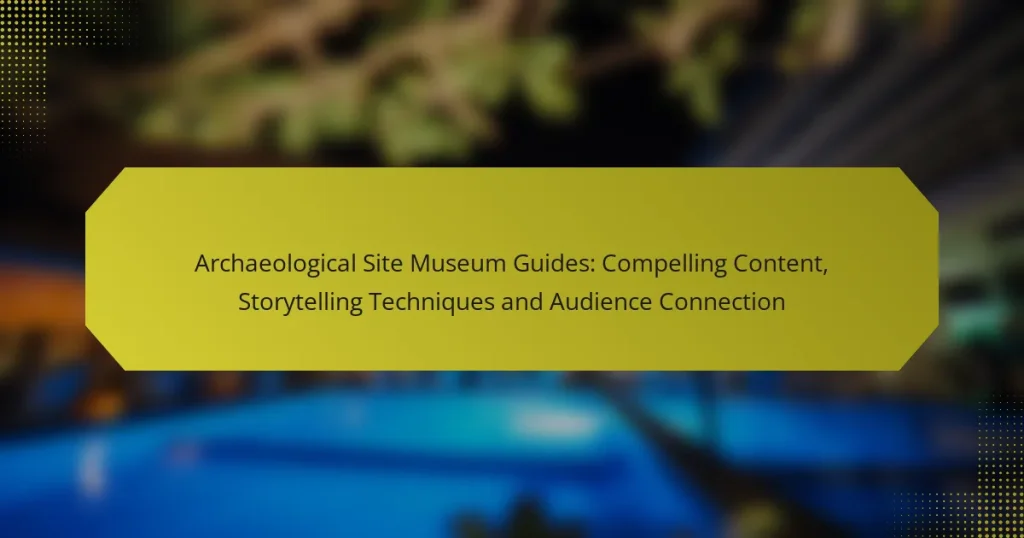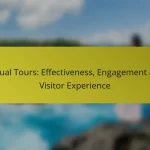Archaeological site museum guides play a crucial role in bridging the gap between the past and present through compelling storytelling and engaging content. By crafting relatable narratives around artifacts and historical events, guides can foster a deeper connection with visitors, enhancing their understanding and appreciation of history. Tailoring these experiences to meet the diverse needs of audiences ensures that museums remain inclusive and impactful.
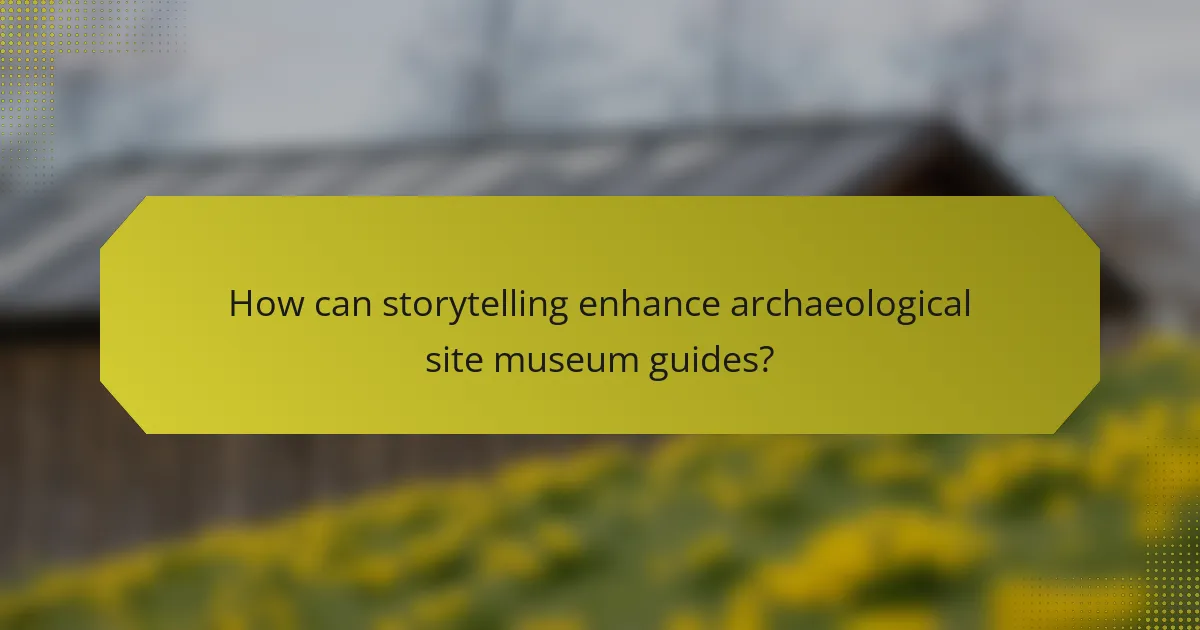
How can storytelling enhance archaeological site museum guides?
Storytelling can significantly enhance archaeological site museum guides by making the information more relatable and memorable. By weaving narratives around artifacts and historical events, guides can create a deeper connection between visitors and the past.
Engaging narratives
Engaging narratives draw visitors into the story of the site, transforming dry facts into compelling tales. For instance, instead of merely stating the date an artifact was discovered, a guide might recount the journey of the archaeologists who unearthed it, adding personal elements that resonate with the audience.
Using vivid descriptions and character-driven stories can help visitors visualize life during the time period being explored. This approach not only captivates attention but also enhances retention of the information presented.
Emotional connections
Creating emotional connections is vital for a memorable museum experience. When guides share stories that evoke feelings—such as loss, triumph, or curiosity—visitors are more likely to engage with the content on a personal level.
For example, recounting the struggles of a community that lived in the area can foster empathy and understanding, making the historical narrative more impactful. Emotional storytelling can transform a simple visit into a profound experience.
Historical context
Providing historical context enriches the visitor’s understanding of artifacts and their significance. By situating items within the broader narrative of the time, guides can explain how they were used, who created them, and what they reveal about the culture.
For instance, discussing the socio-political climate during the era of a specific artifact can help visitors grasp its importance. This contextualization encourages deeper exploration and appreciation of the site’s history.
Interactive experiences
Interactive experiences can significantly enhance storytelling in museum guides. Incorporating hands-on elements, such as replicas or immersive displays, allows visitors to engage directly with the material.
For example, a guided tour might include opportunities for visitors to handle replicas of tools used by ancient peoples, fostering a tactile connection to the past. This interaction can make the stories shared more vivid and relatable.
Multimedia integration
Multimedia integration enhances storytelling by appealing to various learning styles. Using audio, video, and digital displays can bring stories to life, making them more accessible and engaging for a diverse audience.
For instance, a short video depicting a reenactment of a historical event can complement a guide’s narrative, providing visual context that enriches the experience. This combination of media can cater to visual learners and help reinforce the stories being told.
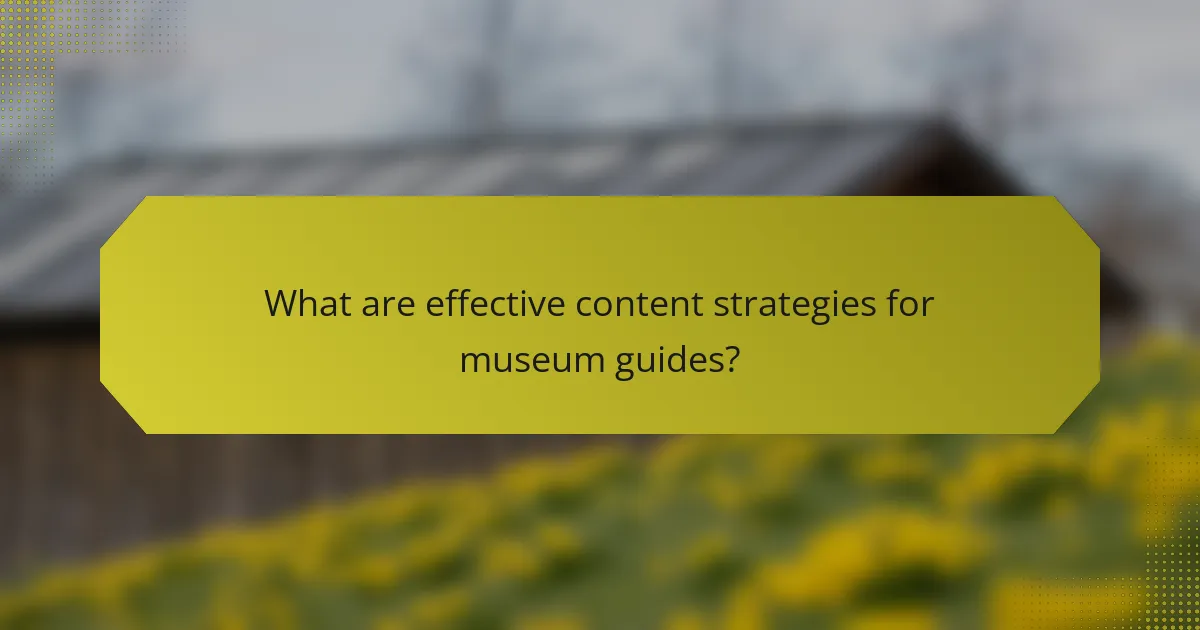
What are effective content strategies for museum guides?
Effective content strategies for museum guides focus on engaging visitors through relatable narratives, clear communication, and immersive experiences. By prioritizing the audience’s needs and interests, museums can create compelling content that enhances learning and connection.
Visitor-centric approach
A visitor-centric approach places the audience at the heart of the museum guide’s content. Understanding the demographics, interests, and motivations of visitors allows museums to tailor their narratives and information accordingly. For instance, families with children may appreciate interactive elements, while academic visitors might seek in-depth historical context.
Gathering feedback through surveys or informal discussions can help refine this approach. Regularly updating content based on visitor preferences ensures relevance and engagement.
Clear messaging
Clear messaging is crucial for effective communication in museum guides. Content should be concise, avoiding jargon and complex language that may alienate visitors. Key messages should be highlighted using bullet points or bold text to enhance readability.
Consider using straightforward language and breaking down complex ideas into digestible segments. This approach helps maintain visitor interest and ensures they grasp essential information quickly.
Visual storytelling
Visual storytelling enhances the narrative by incorporating images, diagrams, and multimedia elements. Engaging visuals can evoke emotions and create a stronger connection to the content. For example, using photographs of artifacts in their original context can help visitors visualize historical events.
Incorporating infographics or short videos can also clarify complex topics and keep visitors engaged. Ensure that visuals complement the text rather than overwhelm it, maintaining a balanced and cohesive presentation.
Expert contributions
Involving experts in the content creation process can significantly enhance the credibility and depth of museum guides. Collaborating with historians, archaeologists, or curators ensures that the information presented is accurate and insightful. Their expertise can also provide unique perspectives that enrich visitor understanding.
Consider featuring quotes or insights from these experts within the guide. This not only adds authority but also personalizes the experience, making visitors feel more connected to the subject matter.
Localized content
Localized content tailors the museum guide to reflect the cultural and historical context of the area. This approach can include references to local history, notable figures, or regional artifacts that resonate with the community. By doing so, museums can foster a sense of pride and relevance among local visitors.
Incorporating local languages or dialects can also enhance accessibility and connection. Ensure that any local regulations or cultural sensitivities are respected in the content to create an inclusive experience for all visitors.
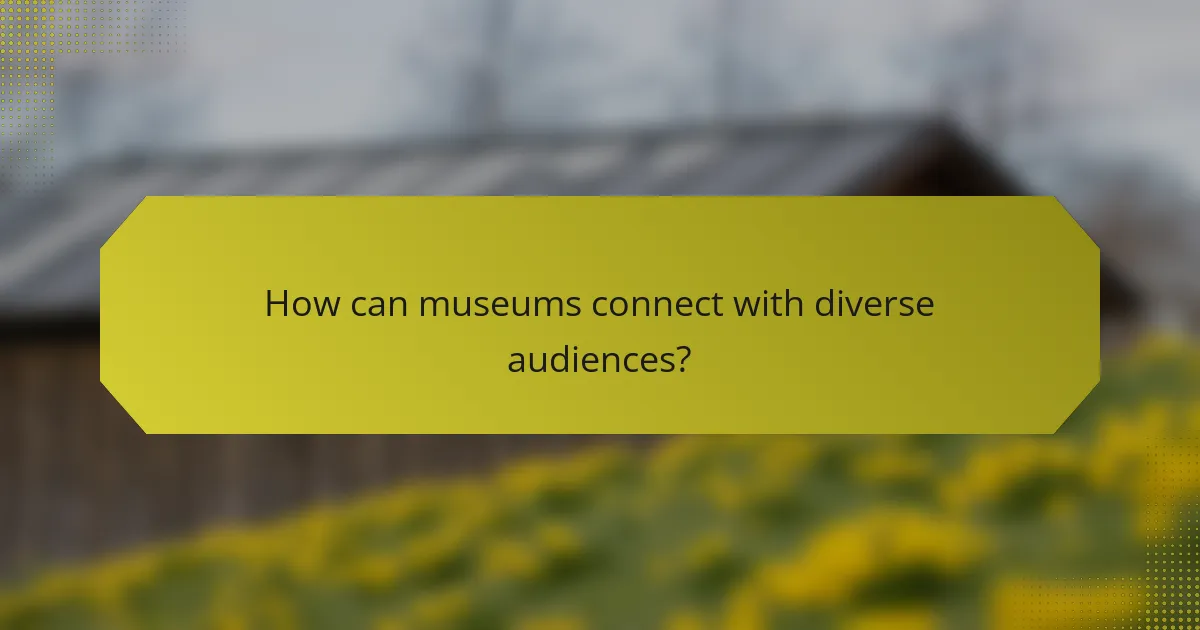
How can museums connect with diverse audiences?
Museums can connect with diverse audiences by implementing strategies that promote inclusivity and engagement. This involves understanding the unique needs of various community groups and tailoring outreach efforts accordingly.
Targeted outreach
Targeted outreach involves identifying specific demographics within the community and creating tailored communication strategies to engage them. For example, museums can use social media platforms popular among younger audiences or collaborate with local organizations that serve underrepresented groups.
Consider hosting events that cater to specific cultural celebrations or interests, ensuring that promotional materials are available in multiple languages. This approach not only increases attendance but also fosters a sense of belonging among diverse visitors.
Inclusive programming
Inclusive programming means designing exhibitions and activities that reflect the diverse backgrounds of the community. This can include featuring artists and historians from various cultures or creating interactive experiences that resonate with different age groups and abilities.
For instance, offering sensory-friendly hours for visitors with autism or providing guided tours in sign language can enhance accessibility. Additionally, incorporating local history and narratives into exhibits can create a deeper connection with the audience.
Community partnerships
Building partnerships with local organizations, schools, and cultural groups can significantly enhance a museum’s reach. Collaborating with these entities allows museums to tap into existing networks and gain insights into the interests and needs of various communities.
Joint programs, such as workshops or community days, can attract diverse audiences and foster a collaborative spirit. For example, partnering with a local school to create a student-led exhibition can engage families and encourage participation from different cultural backgrounds.
Feedback mechanisms
Implementing effective feedback mechanisms is crucial for understanding audience needs and improving museum offerings. This can include surveys, suggestion boxes, or focus groups that invite visitors to share their experiences and recommendations.
Regularly reviewing feedback helps museums adapt their strategies and programming to better serve their audiences. Consider offering incentives for feedback, such as discounts on future visits or exclusive access to events, to encourage participation and demonstrate that visitor input is valued.
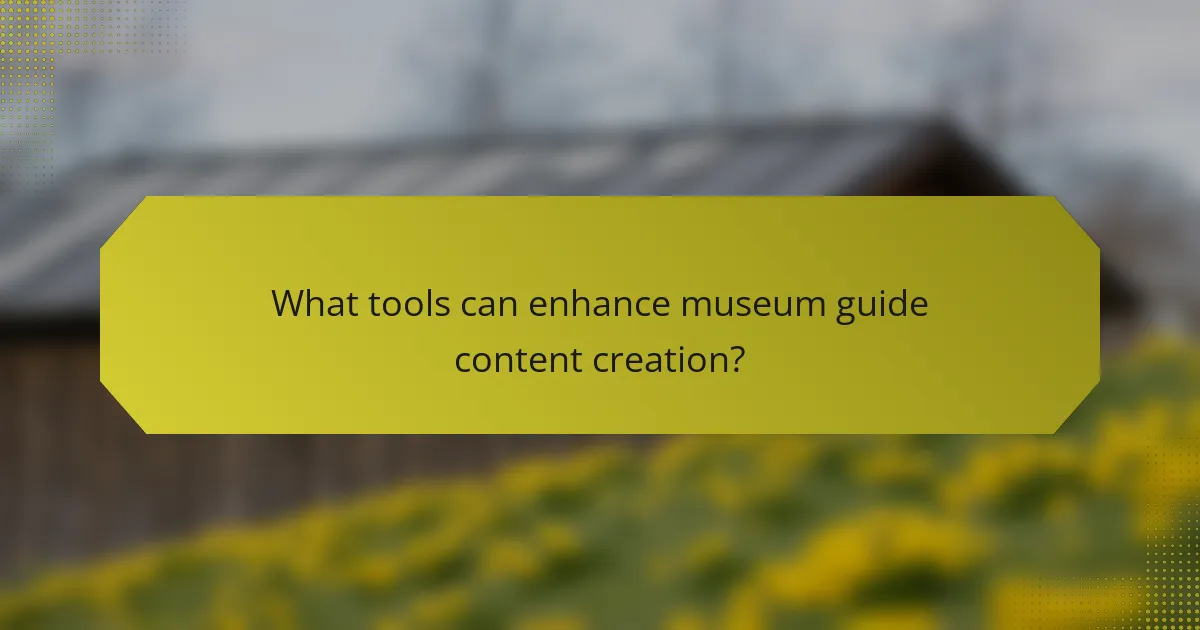
What tools can enhance museum guide content creation?
Several tools can significantly improve the creation of museum guide content, making it more engaging and accessible. These tools range from content management systems to digital storytelling platforms, each offering unique features that cater to different aspects of content development.
Content management systems
Content management systems (CMS) are essential for organizing and managing museum guide content efficiently. They allow curators and content creators to easily upload, edit, and publish materials while maintaining a consistent structure across various platforms.
When selecting a CMS, consider user-friendliness, scalability, and integration capabilities with other tools. Popular options include WordPress and Drupal, which offer customizable templates and plugins tailored for museums.
Digital storytelling platforms
Digital storytelling platforms enable museums to craft compelling narratives around their exhibits. These platforms often support multimedia elements, such as videos, images, and interactive features, enhancing the visitor experience.
Examples of effective digital storytelling tools include StoryMapJS and Adobe Spark, which allow users to create visually appealing stories that can be shared across multiple channels. Focus on platforms that offer ease of use and flexibility to accommodate various content types.
Social media tools
Social media tools are vital for promoting museum guide content and engaging with audiences. They help museums reach wider audiences through platforms like Facebook, Instagram, and Twitter, where visual content thrives.
Utilize scheduling tools like Hootsuite or Buffer to plan and automate posts, ensuring consistent engagement. Additionally, consider using analytics tools to track audience interaction and adjust strategies accordingly for better outreach.
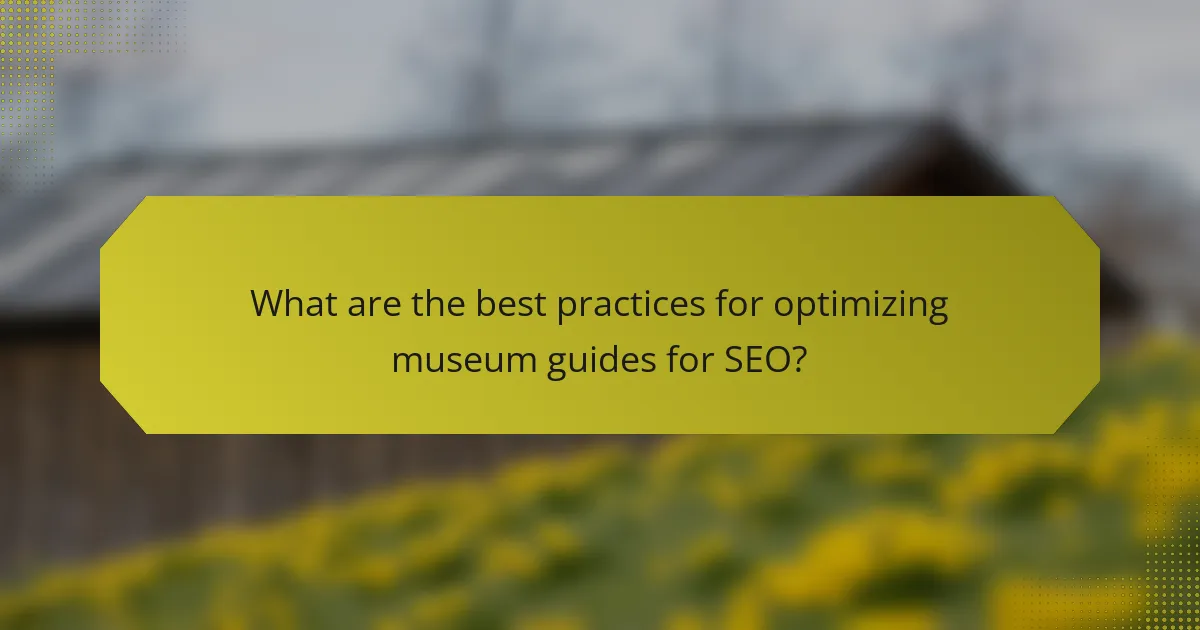
What are the best practices for optimizing museum guides for SEO?
Optimizing museum guides for SEO involves implementing strategies that enhance visibility in search engine results. Key practices include using relevant keywords, creating engaging content, and ensuring mobile-friendliness.
Keyword Research and Implementation
Effective keyword research is crucial for optimizing museum guides. Identify terms that potential visitors might use to search for information about your museum, such as “archaeological exhibits” or “museum tours.” Tools like Google Keyword Planner can help in finding relevant keywords.
Once identified, incorporate these keywords naturally into your content, including titles, headings, and descriptions. Avoid keyword stuffing, as it can lead to penalties from search engines and diminish user experience.
Creating Engaging Content
Engaging content is vital for keeping visitors on your site and encouraging them to explore further. Use storytelling techniques to present the history and significance of exhibits, making the information relatable and interesting.
Incorporate multimedia elements like images, videos, and interactive features to enhance the visitor experience. This not only improves engagement but can also lead to higher rankings in search results due to increased time spent on the page.
Mobile Optimization
With a significant portion of users accessing information via mobile devices, ensuring your museum guides are mobile-friendly is essential. A responsive design that adapts to various screen sizes improves usability and accessibility.
Test your website’s mobile performance using tools like Google’s Mobile-Friendly Test. Aim for fast loading times, ideally under three seconds, to reduce bounce rates and improve user satisfaction.
Local SEO Strategies
For museums, local SEO is particularly important as it helps attract visitors from nearby areas. Ensure your museum’s name, address, and phone number (NAP) are consistent across all online platforms, including Google My Business.
Encourage visitors to leave reviews and ratings, as positive feedback can enhance your local search visibility. Additionally, consider creating content that highlights local events or partnerships to further engage the community.
